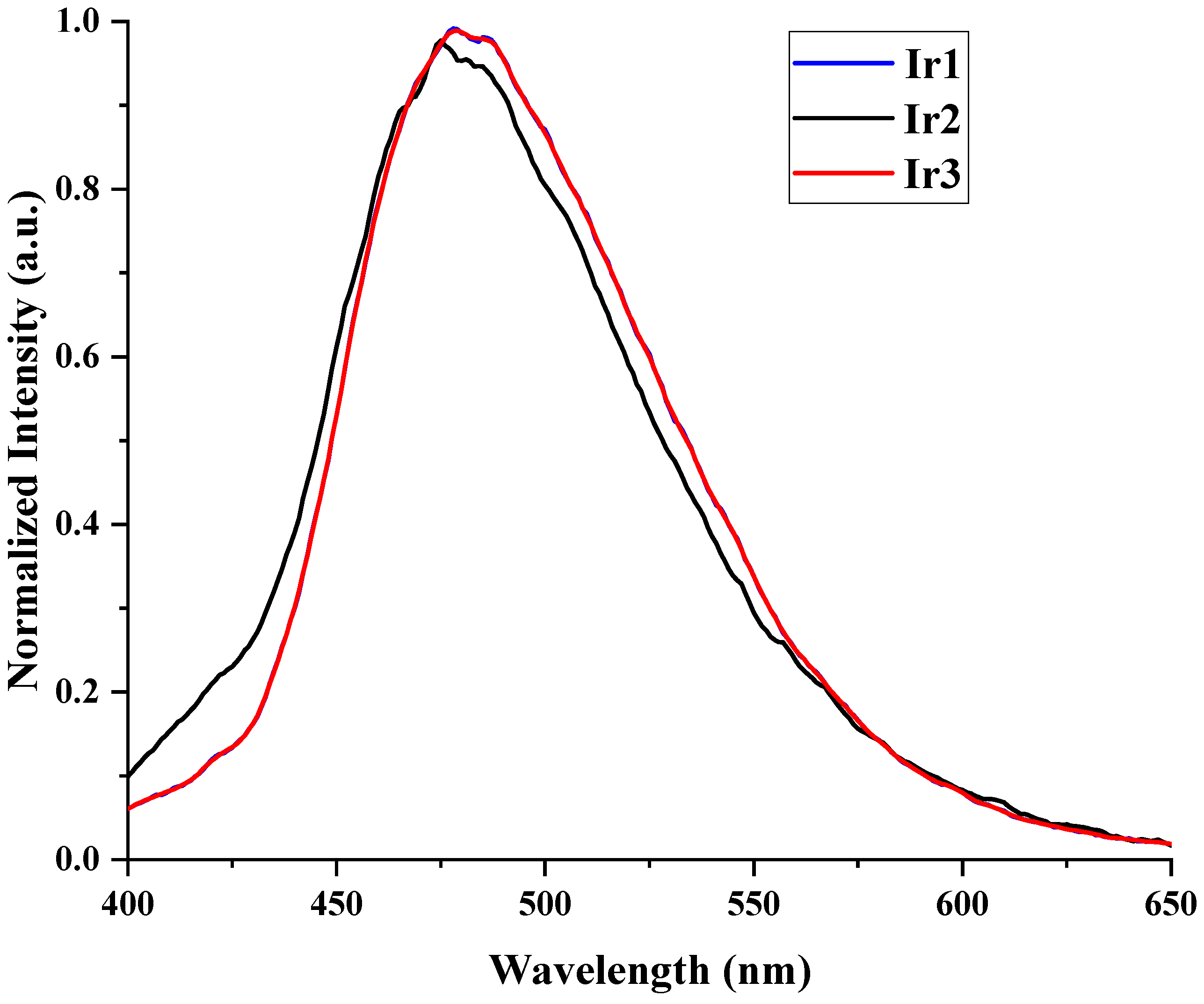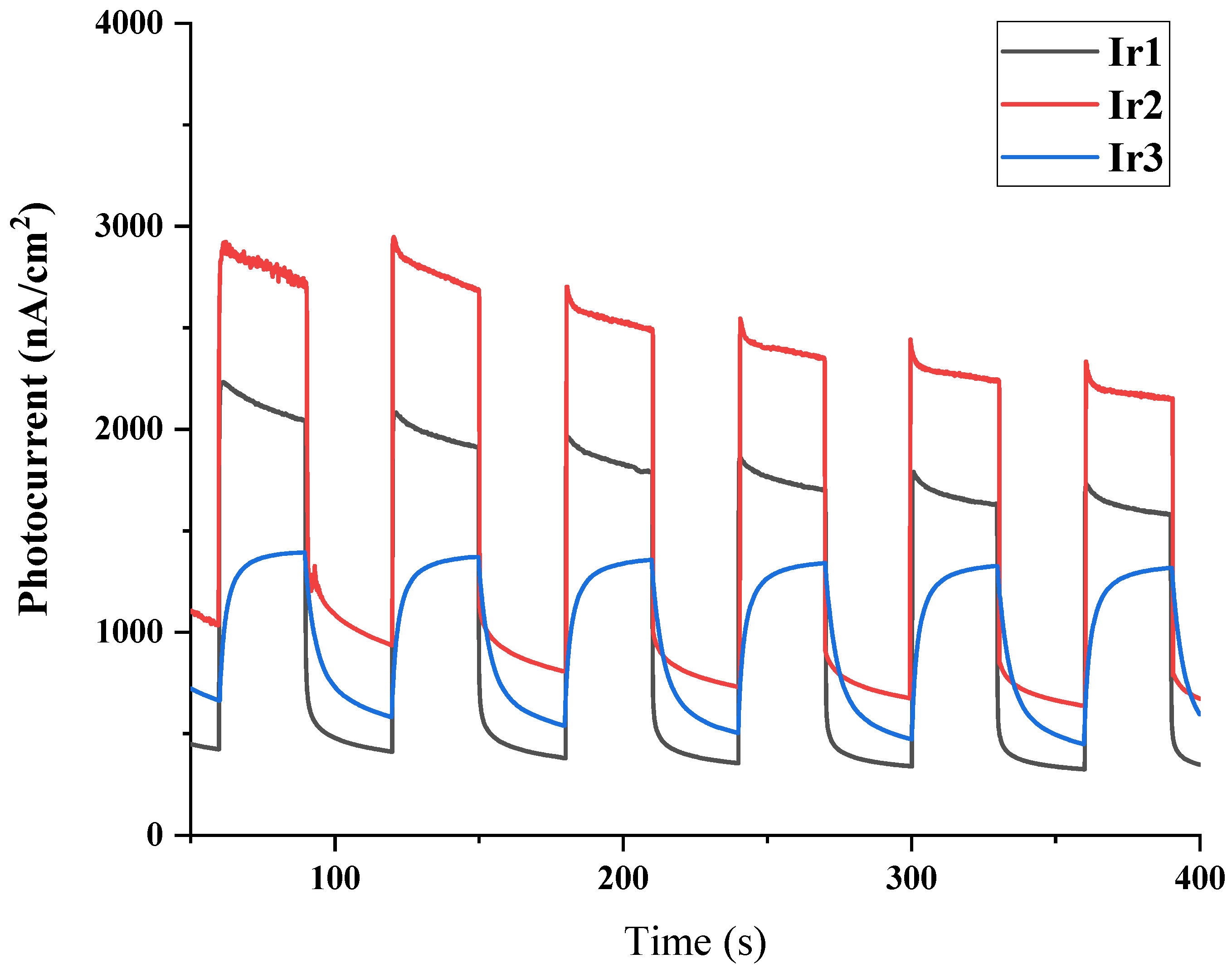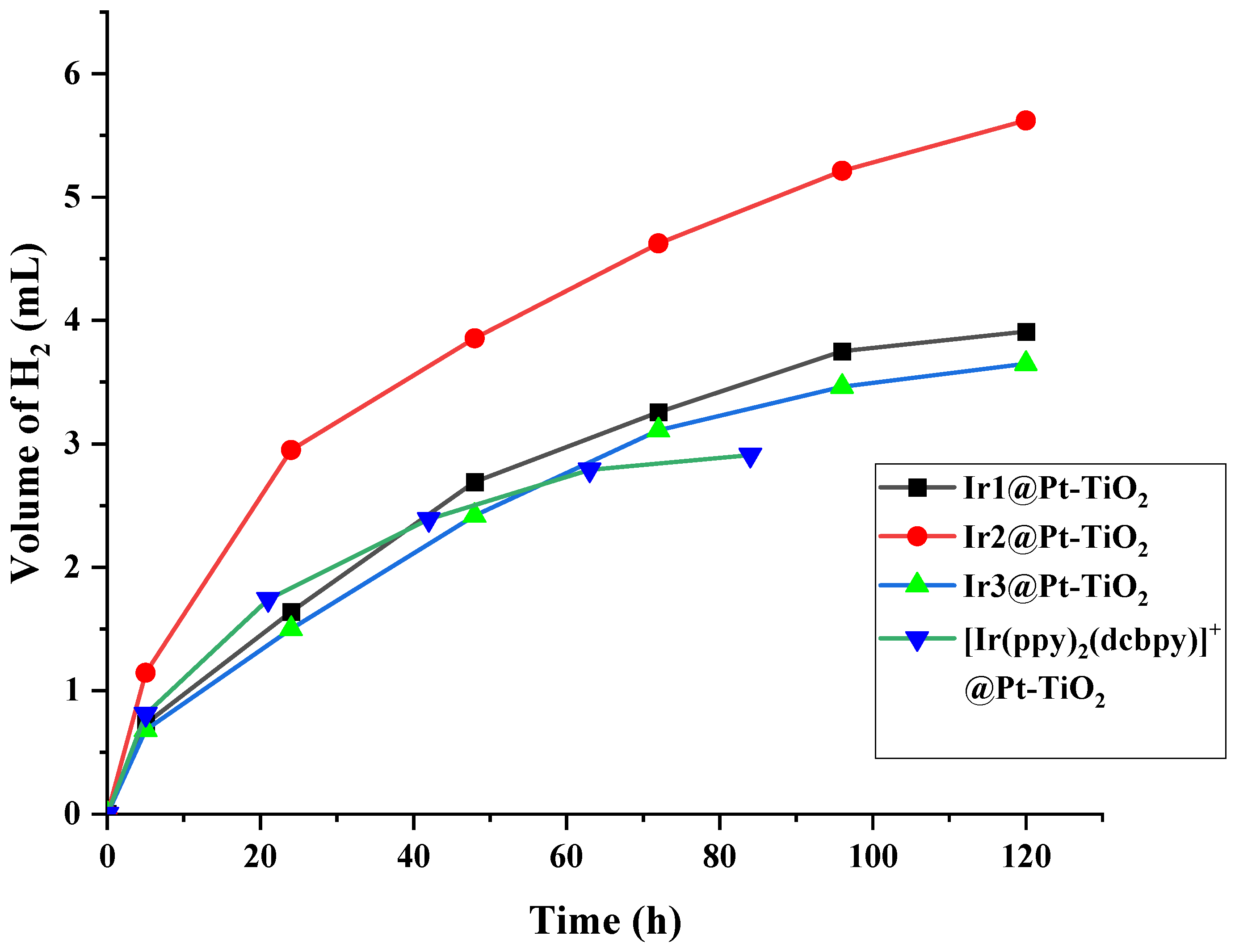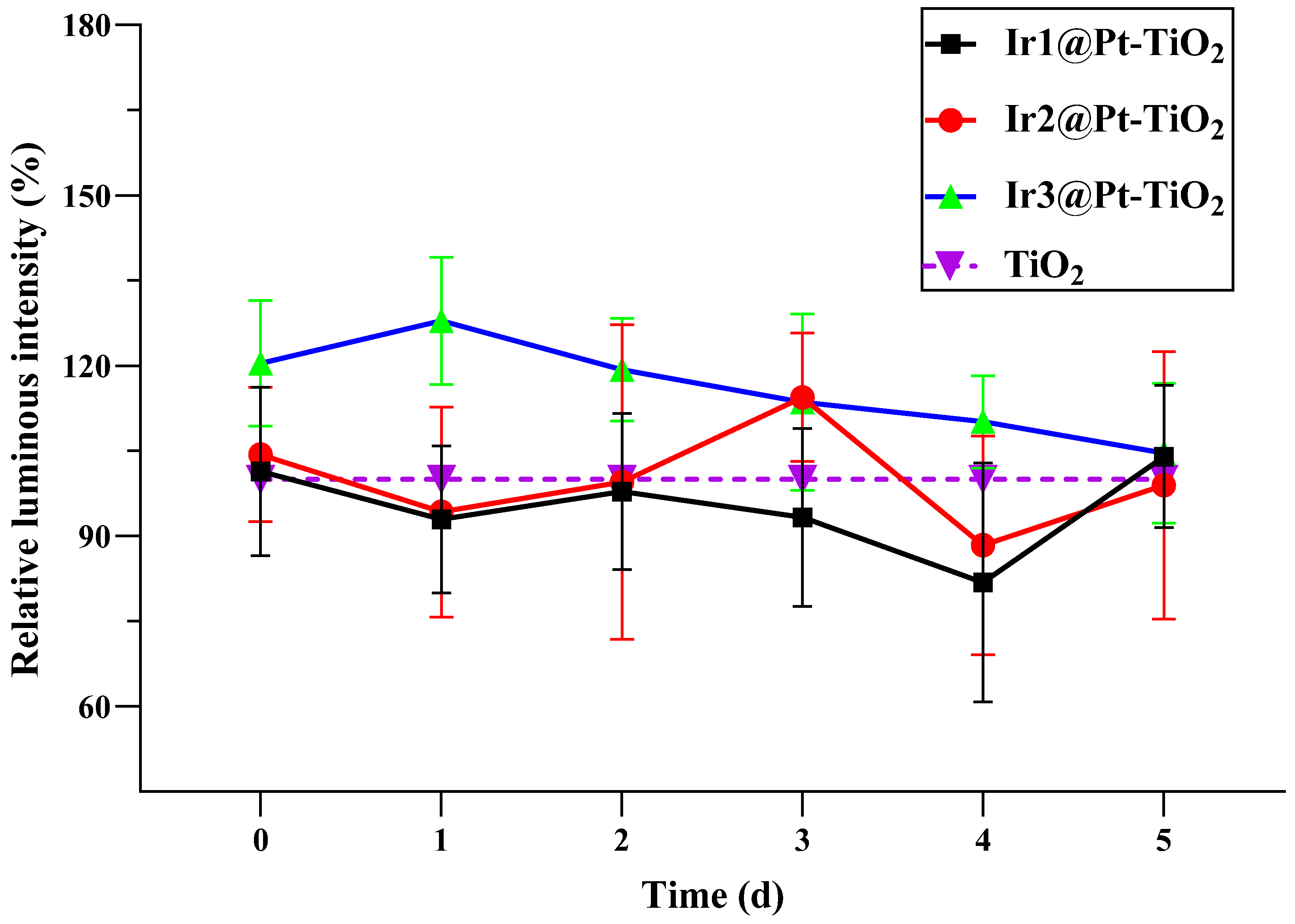Impact of Anchoring Groups on the Photocatalytic Performance of Iridium(III) Complexes and Their Toxicological Analysis
Abstract
1. Introduction
2. Results and Discussion
2.1. Synthesis and Characterization
2.2. Photophysical Properties of Iridium(III) Dyes
2.3. Electrochemical Properties of Iridium(III) Dyes
2.4. Electrochemical Impedance Spectroscopy (EIS) of Iridium(III) Dyes
2.5. Photocurrent Measurements of Iridium(III) Dyes
2.6. Electron Paramagnetic Resonance (EPR) Studies of Ir@Pt-TiO2
2.7. Light-Driven Hydrogen Generation Studies of Ir@Pt-TiO2
2.8. Toxicity Detection of Ir@Pt-TiO2
3. Materials and Methods
3.1. Materials and Reagents
3.2. Synthesis of Materials
4. Conclusions
Supplementary Materials
Author Contributions
Funding
Institutional Review Board Statement
Informed Consent Statement
Data Availability Statement
Conflicts of Interest
References
- Chu, S.; Majumdar, A. Opportunities and challenges for a sustainable energy future. Nature 2012, 488, 294–303. [Google Scholar] [CrossRef] [PubMed]
- Yang, M.; Yarnell, J.E.; El Roz, K.; Castellano, F.N. A robust visible-light-harvesting cyclometalated Ir (III) diimine sensitizer for homogeneous photocatalytic hydrogen production. ACS Appl. Energy Mater. 2020, 3, 1842–1853. [Google Scholar] [CrossRef]
- Watanabe, M. Dye-sensitized photocatalyst for effective water splitting catalyst. Sci. Technol. Adv. Mater. 2017, 18, 705–723. [Google Scholar] [CrossRef] [PubMed]
- Zhu, S.S.; Zhang, Z.; Li, Z.; Liu, X. Recent progress on covalent organic frameworks for photocatalytic hydrogen generation via water splitting. Mater. Chem. Front. 2024, 8, 1513–1535. [Google Scholar] [CrossRef]
- Wong, W.Y.; Ho, C.L. Heavy metal organometallic electrophosphors derived from multi-component chromophores. Coord. Chem. Rev. 2009, 253, 1709–1758. [Google Scholar] [CrossRef]
- Wong, W.Y.; Ho, C.L. Functional metallophosphors for effective charge carrier injection/transport: New robust OLED materials with emerging applications. J. Mater. Chem. 2009, 19, 4457–4482. [Google Scholar] [CrossRef]
- Chi, Y.; Chou, P.T. Transition-metal phosphors with cyclometalating ligands: Fundamentals and applications. Chem. Soc. Rev. 2010, 39, 638–655. [Google Scholar] [CrossRef] [PubMed]
- Vilaça, G.; Jousseaume, B.; Mahieux, C.; Belin, C.; Cachet, H.; Bernard, M.C.; Vivier, V.; Toupance, T. Tin dioxide materials chemically modified with trialkynylorganotins: Functional nanohybrids for photovoltaic applications. Adv. Mater. 2006, 18, 1073–1077. [Google Scholar] [CrossRef]
- Sun, X.; Jiang, S.; Huang, H.; Li, H.; Jia, B.; Ma, T. Solar energy catalysis. Angew. Chem. Int. Ed. 2022, 61, e202204880. [Google Scholar] [CrossRef]
- Waheed, H.S.; Ullah, H.; Iqbal, M.W.; Shin, Y.-H. Optoelectronic and photocatalytic properties of Mo-based Janus monolayers for solar cell applications. Optik 2022, 271, 170071. [Google Scholar] [CrossRef]
- Wang, C.J.; Chen, Y.; Fu, W.F. New platinum and ruthenium Schiff base complexes for water splitting reactions. Dalton Trans. 2015, 44, 14483–14493. [Google Scholar] [CrossRef] [PubMed]
- Sahar, K.U.; Rafiq, K.; Abid, M.Z.; Rauf, A.; Ur Rehman, U.; Nadeem, M.A.; Jin, R.; Hussain, E. Sun-light driven hydrogen generation by Pd/Rb2O cocatalysts: Escalate the utility of rutile TiO2 for photocatalytic water splitting. Colloids Surf. A Physicochem. Eng. Asp. 2023, 674, 131942. [Google Scholar] [CrossRef]
- Fujishima, A.; Honda, K. Electrochemical photolysis of water at a semiconductor electrode. Nature 1972, 238, 37–38. [Google Scholar] [CrossRef]
- Singh, R.; Dutta, S. A review on H2 production through photocatalytic reactions using TiO2/TiO2-assisted catalysts. Fuel 2018, 220, 607–620. [Google Scholar] [CrossRef]
- Gupta, A.; Likozar, B.; Jana, R.; Chanu, W.C.; Singh, M.K. A review of hydrogen production processes by photocatalytic water splitting–From atomistic catalysis design to optimal reactor engineering. Int. J. Hydrogen Energy 2022, 47, 33282–33307. [Google Scholar] [CrossRef]
- Tritton, D.N.; Tang, F.K.; Bodedla, G.B.; Lee, F.W.; Kwan, C.-S.; Leung, K.C.F.; Zhu, X.; Wong, W.Y. Development and advancement of iridium (III)-based complexes for photocatalytic hydrogen evolution. Coord. Chem. Rev. 2022, 459, 214390. [Google Scholar] [CrossRef]
- Deaton, J.C.; Castellano, F.N. Archetypal iridium (III) compounds for optoelectronic and photonic applications: Photophysical properties and synthetic methods. In Iridium (III) in Optoelectronic and Photonics Applications; Zysman-Colman, E., Ed.; WilEy-VCH: WeinHeim, Germany, 2017; pp. 1–69. [Google Scholar]
- Goldsmith, J.I.; Hudson, W.R.; Lowry, M.S.; Anderson, T.H.; Bernhard, S. Discovery and high-throughput screening of heteroleptic iridium complexes for photoinduced hydrogen production. J. Am. Chem. Soc. 2005, 127, 7502–7510. [Google Scholar] [CrossRef]
- Lowry, M.S.; Bernhard, S. Synthetically tailored excited states: Phosphorescent, cyclometalated iridium (III) complexes and their applications. Chem. Eur. J. 2006, 12, 7970–7977. [Google Scholar] [CrossRef]
- Lowry, M.S.; Goldsmith, J.I.; Slinker, J.D.; Rohl, R.; Pascal, R.A.; Malliaras, G.G.; Bernhard, S. Single-layer electroluminescent devices and photoinduced hydrogen production from an ionic iridium (III) complex. Chem. Mater. 2005, 17, 5712–5719. [Google Scholar] [CrossRef]
- Curtin, P.N.; Tinker, L.L.; Burgess, C.M.; Cline, E.D.; Bernhard, S. Structure−activity correlations among iridium (III) photosensitizers in a robust water-reducing system. Inorg. Chem. 2009, 48, 10498–10506. [Google Scholar] [CrossRef]
- Tinker, L.L.; Mcdaniel, N.D.; Curtin, P.N.; Smith, C.K.; Ireland, M.J.; Bernhard, S. Visible light induced catalytic water reduction without an electron relay. Chem. Eur. J. 2007, 13, 8726–8732. [Google Scholar] [CrossRef]
- Tinker, L.L.; Bernhard, S. Photon-driven catalytic proton Reduction with a robust homoleptic iridium (III) 6-phenyl-2,2′-bipyridine complex (Ir(C^N^N)2+). Inorg. Chem. 2009, 48, 10507–10511. [Google Scholar] [CrossRef]
- Metz, S.; Bernhard, S. Robust photocatalytic water reduction with cyclometalated Ir (III) 4-vinyl-2,2′-bipyridine complexes. Chem. Commun. 2010, 46, 7551–7553. [Google Scholar] [CrossRef] [PubMed]
- Bodedla, G.B.; Tritton, D.N.; Chen, X.; Zhao, J.; Guo, Z.; Leung, K.C.-F.; Wong, W.-Y.; Zhu, X. Cocatalyst-free photocatalytic hydrogen evolution with simple heteroleptic iridium (III) complexes. ACS Appl. Energy Mater. 2021, 4, 3945–3951. [Google Scholar] [CrossRef]
- Yao, X.; Zhang, Q.; Ho, P.Y.; Yiu, S.C.; Suramitr, S.; Hannongbua, S.; Ho, C.L. Development of Aldehyde Functionalized Iridium (III) Complexes Photosensitizers with Strong Visible-Light Absorption for Photocatalytic Hydrogen Generation from Water. Inorganics 2023, 11, 110. [Google Scholar] [CrossRef]
- Schreier, M.R.; Guo, X.; Pfund, B.R.; Okamoto, Y.; Ward, T.R.; Kerzig, C.; Wenger, O.S. Water-soluble tris(cyclometalated) iridium (III) complexes for aqueous electron and energy transfer photochemistry. Acc. Chem. Res. 2022, 55, 1290–1300. [Google Scholar] [CrossRef] [PubMed]
- Juban, E.A.; Smeigh, A.L.; Monat, J.E.; Mccusker, J.K. Ultrafast dynamics of ligand-field excited states. Coord. Chem. Rev. 2006, 250, 1783–1791. [Google Scholar] [CrossRef]
- Pal, Y.; Fiala, T.A.; Swords, W.B.; Yoon, T.P.; Schmidt, J.R. Predicting Emission of Heteroleptic Iridium Complexes using Artificial Chemical Intelligence. ChemPhysChem 2024, e202400176. [Google Scholar] [CrossRef]
- Wang, Y.; Zhao, X.; Zhao, Y.; Yang, T.; Liu, X.; Xie, J.; Li, G.; Zhu, D.; Tan, H.; Su, Z. Photosensitizers based on Ir (III) complexes for highly efficient photocatalytic hydrogen generation. Dye. Pigment. 2019, 170, 107547. [Google Scholar] [CrossRef]
- Takizawa, S.; Pérez-Bolívar, C.; Anzenbacher, P., Jr.; Murata, S. cationic iridium complexes coordinated with coumarin dyes–sensitizers for visible-Light-driven hydrogen generation. Eur. J. Inorg. Chem. 2012, 2012, 3975–3979. [Google Scholar] [CrossRef]
- Zhao, J.; Wu, W.; Sun, J.; Guo, S. Triplet photosensitizers: From molecular design to applications. Chem. Soc. Rev. 2013, 42, 5323–5351. [Google Scholar] [CrossRef]
- Siu, C.; Ho, C.; He, J.; Chen, T.; Cui, X.N.; Zhao, J.Z.; Wong, W. Thiocyanate-free ruthenium (II) cyclometalated complexes containing uncommon thiazole and benzothiazole chromophores for dye-sensitized solar cells. J. Organomet. Chem. 2013, 748, 75–83. [Google Scholar] [CrossRef]
- Pala, L.P.R.; Peela, N.R. Visible light active IrO2/TiO2 films for oxygen evolution from photocatalytic water splitting in an optofluidic planar microreactor. Renew. Energy 2022, 197, 902–910. [Google Scholar] [CrossRef]
- Adeloye, A.O.; Ajibade, P.A. Towards the Development of Functionalized PolypyridineLigands for Ru (II) Complexes as Photosensitizers inDye-Sensitized Solar Cells (DSSCs). Molecules 2014, 19, 12421–12460. [Google Scholar] [CrossRef] [PubMed]
- Yiu, S.C.; Ho, P.Y.; Kwok, Y.Y.; He, X.; Wang, Y.; Yu, W.H.; Ho, C.L.; Huang, S. Development of Strong Visible-Light-Absorbing Cyclometalated Iridium (III) Complexes for Robust and Efficient Light-Driven Hydrogen Production. Chem. Eur. J. 2022, 28, e202104575. [Google Scholar] [CrossRef]
- Kausar, F.; Varghese, A.; Pinheiro, D.; Kr, S.D. Recent trends in photocatalytic water splitting using titania based ternary photocatalysts-A review. Int. J. Hydrogen Energy 2022, 47, 22371–22402. [Google Scholar] [CrossRef]
- Wadman, S.H.; Kroon, J.M.; Bakker, K.; Havenith, R.W.; Van Klink, G.P.; Van Koten, G. Cyclometalated organoruthenium complexes for application in dye-sensitized solar cells. Organometallics 2010, 29, 1569–1579. [Google Scholar] [CrossRef]
- Saber, A.F.; Elewa, A.M.; Chou, H.-H.; El-Mahdy, A.F. Donor-acceptor carbazole-based conjugated microporous polymers as photocatalysts for visible-light-driven H2 and O2 evolution from water splitting. Appl. Catal. B 2022, 316, 121624. [Google Scholar] [CrossRef]
- Wang, W.H.; Ting, L.Y.; Jayakumar, J.; Chang, C.L.; Lin, W.C.; Chung, C.C.; Elsayed, M.H.; Lu, C.Y.; Elewa, A.M.; Chou, H.H. Design and synthesis of phenylphosphine oxide-based polymer photocatalysts for highly efficient visible-light-driven hydrogen evolution. Sustain. Energy Fuels 2020, 4, 5264–5270. [Google Scholar] [CrossRef]
- Liu, Q.; Wu, L.; Chen, M.; Guo, Y.; Xie, T.; Wang, P. Aromatic TpyRu2+ (L)2Cl derivatives as water oxidation catalysts (Tpy = 2,2′:6′,2″-terpyridine, Ru = ruthenium, L = pyridine or isoquinoline). Catal. Commun. 2019, 122, 38–42. [Google Scholar] [CrossRef]
- Tang, X.L.; Liu, W.M.; Wu, J.S.; Lee, C.S.; You, J.J.; Wang, P.F. Synthesis, crystal structures, and photophysical properties of triphenylamine-based multicyano derivatives. J. Org. Chem. 2010, 75, 7273–7278. [Google Scholar] [CrossRef]
- Chen, R.K.; Zhao, G.J.; Yang, X.C.; Jiang, X.; Liu, J.F.; Tian, H.N.; Gao, Y.; Liu, X.E.; Han, K.L.; Sun, M.T. Photoinduced intramolecular charge-transfer state in thiophene-π-conjugated donor–acceptor molecules. J. Mol. Struct. 2008, 876, 102–109. [Google Scholar] [CrossRef]
- Kobayashi, A.; Watanabe, S.; Yoshida, M.; Kato, M. Importance of the molecular orientation of an iridium (III)-heteroleptic photosensitizer immobilized on TiO2 nanoparticles. ACS Appl. Energy Mater. 2018, 1, 2882–2890. [Google Scholar] [CrossRef]
- Wahyuono, R.A.; Amthor, S.; Müller, C.; Rau, S.; Dietzek, B. Structure of Diethyl-Phosphonic Acid Anchoring Group Affects the Charge-Separated State on an Iridium (III) Complex Functionalized NiO Surface. ChemPhotoChem 2020, 4, 618–629. [Google Scholar] [CrossRef]
- Marin, V.; Holder, E.; Hoogenboom, R.; Schubert, U.S. Functional ruthenium (II)-and iridium (III)-containing polymers for potential electro-optical applications. Chem. Soc. Rev. 2007, 36, 618–635. [Google Scholar] [CrossRef]
- Yuan, Y.J.; Yu, Z.T.; Chen, X.Y.; Zhang, J.Y.; Zou, Z.G. Visible-Light-Driven H2 Generation from Water and CO2 Conversion by Using a Zwitterionic Cyclometalated Iridium (III) Complex. Chem. Eur. J. 2011, 17, 12891–12895. [Google Scholar] [CrossRef]
- Jiang, W.; Gao, Y.; Sun, Y.; Ding, F.; Xu, Y.; Bian, Z.; Li, F.; Bian, J.; Huang, C. Zwitterionic iridium complexes: Synthesis, luminescent properties, and their application in cell imaging. Inorg. Chem. 2010, 49, 3252–3260. [Google Scholar] [CrossRef]
- Himeda, Y.; Onozawa-Komatsuzaki, N.; Sugihara, H.; Kasuga, K. Simultaneous tuning of activity and water solubility of complex catalysts by acid−base equilibrium of ligands for conversion of carbon dioxide. Organometallics 2007, 26, 702–712. [Google Scholar] [CrossRef]
- Zhao, J.; Ji, S.; Wu, W.; Wu, W.; Guo, H.; Sun, J.; Sun, H.; Liu, Y.; Li, Q.; Huang, L. Transition metal complexes with strong absorption of visible light and long-lived triplet excited states: From molecular design to applications. RSC Adv. 2012, 2, 1712–1728. [Google Scholar] [CrossRef]
- Murakami, T.N.; Yoshida, E.; Koumura, N. Carbazole dye with phosphonic acid anchoring groups for long-term heat stability of dye-sensitized solar cells. Electrochim. Acta 2014, 131, 174–183. [Google Scholar] [CrossRef]
- Bae, E.; Choi, W.; Park, J.; Shin, H.S.; Kim, S.B.; Lee, J.S. Effects of surface anchoring groups (carboxylate vs phosphonate) in ruthenium-complex-sensitized TiO2 on visible light reactivity in aqueous suspensions. J. Chem. Phys. B. 2004, 108, 14093–14101. [Google Scholar] [CrossRef]
- Zhang, W.X.; Li, B.; Ma, H.P.; Zhang, L.M.; Guan, Y.L.; Zhang, Y.H.; Zhang, X.D.; Jing, P.T.; Yue, S.M. Combining ruthenium (II) complexes with metal–organic frameworks to realize effective two-photon absorption for singlet oxygen generation. ACS Appl. Mater. Interfaces 2016, 8, 21465–21471. [Google Scholar] [CrossRef] [PubMed]
- Pitre, S.P.; Mctiernan, C.D.; Vine, W.; Dipucchio, R.; Grenier, M.; Scaiano, J.C. Visible-light actinometry and intermittent illumination as convenient tools to study Ru(bpy)3Cl2 mediated photoredox transformations. Sci. Rep. 2015, 5, 16397. [Google Scholar] [CrossRef] [PubMed]
- Filevich, O.; Zayat, L.; Baraldo, L.M.; Etchenique, R. Long wavelength phototriggering: Ruthenium-based caged compounds. In Luminescent and Photoactive Transition Metal Complexes as Biomolecular Probes and Cellular Reagents; Lo, K., Ed.; Springer: Heidelberg, Germany, 2014; pp. 47–68. [Google Scholar]
- Li, G.C.; Hu, K.; Robson, K.C.; Gorelsky, S.I.; Meyer, G.J.; Berlinguette, C.P.; Shatruk, M. Tris-Heteroleptic Ruthenium–Dipyrrinate Chromophores in a Dye-Sensitized Solar Cell. Chem. Eur. J. 2015, 21, 2173–2181. [Google Scholar] [CrossRef] [PubMed]
- Yao, X.; Ho, P.Y.; Yiu, S.C.; Suramitr, S.; Li, W.B.; Ho, C.L.; Hannongbua, S. Development of new thiocyanate-free Ruthenium(II) dyes bearing isoquinoline chromophores for hydrogen production via water splitting. Dye. Pigment. 2022, 205, 110508. [Google Scholar] [CrossRef]
- Ma, D.-L.; Lin, S.; Wang, W.; Yang, C.; Leung, C.-H. Luminescent chemosensors by using cyclometalated iridium (III) complexes and their applications. Chem. Sci. 2017, 8, 878–889. [Google Scholar] [CrossRef] [PubMed]
- Yuan, Y.J.; Zhang, J.Y.; Yu, Z.T.; Feng, J.Y.; Luo, W.J.; Ye, J.H.; Zou, Z.G. Impact of ligand modification on hydrogen photogeneration and light-harvesting applications using cyclometalated iridium complexes. Inorg. Chem. 2012, 51, 4123–4133. [Google Scholar] [CrossRef] [PubMed]
- Alsaeedi, M.S. Deep-blue light–emitting cationic iridium (III) complexes featuring diamine ancillary ligands: Experimental and theoretical investigations. Spectrochim. Acta A. 2024, 310, 123935. [Google Scholar] [CrossRef] [PubMed]
- Wu, S.H.; Ling, J.W.; Lai, S.H.; Huang, M.J.; Cheng, C.H.; Chen, I.C. Dynamics of the excited states of [Ir(ppy)2bpy]+ with triple phosphorescence. J. Phys. Chem. A 2010, 114, 10339–10344. [Google Scholar] [CrossRef]
- Wang, P.; Guo, S.; Wang, H.J.; Chen, K.K.; Zhang, N.; Zhang, Z.M.; Lu, T.B. A broadband and strong visible-light-absorbing photosensitizer boosts hydrogen evolution. Nat. Commun. 2019, 10, 3155. [Google Scholar] [CrossRef]
- Zara, Z.; Iqbal, J.; Ayub, K.; Irfan, M.; Mahmood, A.; Khera, R.A.; Eliasson, B. A comparative study of DFT calculated and experimental UV/Visible spectra for thirty carboline and carbazole based compounds. J. Mol. Struct. 2017, 1149, 282–298. [Google Scholar] [CrossRef]
- Wu, Y.; Zhu, W. Organic sensitizers from D–π–A to D–A–π–A: Effect of the internal electron-withdrawing units on molecular absorption, energy levels and photovoltaic performances. Chem. Soc. Rev. 2013, 42, 2039–2058. [Google Scholar] [CrossRef] [PubMed]
- Tsuboyama, A.; Iwawaki, H.; Furugori, M.; Mukaide, T.; Kamatani, J.; Igawa, S.; Moriyama, T.; Miura, S.; Takiguchi, T.; Okada, S.; et al. Homoleptic cyclometalated iridium complexes with highly efficient red phosphorescence and application to organic light-emitting diode. J. Am. Chem. Soc. 2003, 125, 12971–12979. [Google Scholar] [CrossRef] [PubMed]
- Bandini, M.; Bianchi, M.; Valenti, G.; Piccinelli, F.; Paolucci, F.; Monari, M.; Umani-Ronchi, A.; Marcaccio, M. Electrochemiluminescent functionalizable cyclometalated thiophene-based iridium(III) complexes. Inorg. Chem. 2010, 49, 1439–1448. [Google Scholar] [CrossRef] [PubMed]
- Bessho, T.; Yoneda, E.; Yum, J.-H.; Guglielmi, M.; Tavernelli, I.; Imai, H.; Rothlisberger, U.; Nazeeruddin, M.K.; GräTzel, M. New paradigm in molecular engineering of sensitizers for solar cell applications. J. Am. Chem. Soc. 2009, 131, 5930–5934. [Google Scholar] [CrossRef] [PubMed]
- Ji, Z.; Natu, G.; Wu, Y. Cyclometalated ruthenium sensitizers bearing a triphenylamino group for p-type NiO dye-sensitized solar cells. ACS Appl. Mater. Interfaces 2013, 5, 8641–8648. [Google Scholar] [CrossRef] [PubMed]
- Sebata, S.; Takizawa, S.-Y.; Ikuta, N.; Murata, S. Photofunctions of iridium (iii) complexes in vesicles: Long-lived excited states and visible-light sensitization for hydrogen evolution in aqueous solution. Dalton Trans. 2019, 48, 14914–14925. [Google Scholar] [CrossRef] [PubMed]
- Tian, P.; He, X.; Zhao, L.; Li, W.; Fang, W.; Chen, H.; Zhang, F.; Huang, Z.; Wang, H. Enhanced charge transfer for efficient photocatalytic H2 evolution over UiO-66-NH2 with annealed Ti3C2Tx MXenes. Int. J. Hydrogen Energy 2019, 44, 788–800. [Google Scholar] [CrossRef]
- Tian, P.; He, X.; Zhao, L.; Li, W.; Fang, W.; Chen, H.; Zhang, F.; Huang, Z.; Wang, H. Ti3C2 nanosheets modified Zr-MOFs with Schottky junction for boosting photocatalytic HER performance. Sol. Energy 2019, 188, 750–759. [Google Scholar] [CrossRef]
- Wang, H.; Gao, C.; Li, R.; Peng, Z.; Yang, J.; Gao, J.; Yang, Y.; Li, S.; Li, B.; Liu, Z. Ruthenium–cobalt nanoalloy embedded within hollow carbon spheres as a bifunctionally robust catalyst for hydrogen generation from water splitting and ammonia borane hydrolysis. ACS Sustain. Chem. Eng. 2019, 7, 18744–18752. [Google Scholar] [CrossRef]
- Wang, Y.; Zheng, P.; Li, M.; Li, Y.; Zhang, X.; Chen, J.; Fang, X.; Liu, Y.; Yuan, X.; Dai, X.; et al. Interfacial synergy between dispersed Ru sub-nanoclusters and porous NiFe layered double hydroxide on accelerated overall water splitting by intermediate modulation. Nanoscale 2020, 12, 9669–9679. [Google Scholar] [CrossRef]
- Acharya, R.; Naik, B.; Parida, K. Cr (VI) remediation from aqueous environment through modified-TiO2-mediated photocatalytic reduction. Beilstein J. Nanotechnol. 2018, 9, 1448–1470. [Google Scholar] [CrossRef] [PubMed]
- Zhang, Y.; Liu, Z.; Guo, C.; Chen, T.; Guo, C.; Lu, Y.; Wang, J. CdS (ZB)/CdS (WZ)/Ni-BTC photocatalytic selective oxidation of benzyl alcohol to benzaldehyde coupled with hydrogen evolution. Appl. Surf. Sci. 2022, 571, 151284. [Google Scholar] [CrossRef]
- Jiang, D.; Wang, W.; Sun, S.; Zhang, L.; Zheng, Y. Equilibrating the plasmonic and catalytic roles of metallic nanostructures in photocatalytic oxidation over Au-modified CeO2. ACS Catal. 2015, 5, 613–621. [Google Scholar] [CrossRef]
- Peerakiatkhajohn, P.; Yun, J.H.; Wang, S.; Wang, L. Review of recent progress in unassisted photoelectrochemical water splitting: From material modification to configuration design. J. Photonics Energy 2017, 7, 012006. [Google Scholar] [CrossRef]
- Tang, J.Y.; Guo, R.T.; Zhou, W.G.; Huang, C.Y.; Pan, W.G. Ball-flower like NiO/g-C3N4 heterojunction for efficient visible light photocatalytic CO2 reduction. Appl. Catal. B 2018, 237, 802–810. [Google Scholar] [CrossRef]
- Cao, S.; Huang, Q.; Zhu, B.; Yu, J. Trace-level phosphorus and sodium co-doping of g-C3N4 for enhanced photocatalytic H2 production. J. Power Sources 2017, 351, 151–159. [Google Scholar] [CrossRef]
- Leng, F.; Liu, H.; Ding, M.; Lin, Q.-P.; Jiang, H.-L. Boosting photocatalytic hydrogen production of porphyrinic MOFs: The metal location in metalloporphyrin matters. ACS Catal. 2018, 8, 4583–4590. [Google Scholar] [CrossRef]
- Liu, Z.; Zhu, M.; Meng, X.; Xu, G.; Jin, R. Electron transfer between [Au25(SC2H4Ph)18]− TOA+ and oxoammonium cations. J. Phys. Chem. Lett. 2011, 2, 2104–2109. [Google Scholar] [CrossRef]
- Li, Y.; Wang, Z.; Wang, Y.; Kovács, A.; Foo, C.; Dunin-Borkowski, R.E.; Lu, Y.; Taylor, R.A.; Wu, C.; Tsang, S.C.E. Local magnetic spin mismatch promoting photocatalytic overall water splitting with exceptional solar-to-hydrogen efficiency. Energy Environ. Sci. 2022, 15, 265–277. [Google Scholar] [CrossRef]
- Légalité, F.; Escudero, D.; Pellegrin, Y.; Blart, E.; Jacquemin, D.; Fabrice, O. “Iridium effect” in cyclometalated iridium complexes for p-type dye sensitized solar cells. Dye. Pigment. 2019, 171, 107693. [Google Scholar] [CrossRef]
- Ha, M.W.; Park, M.-H.; Hwang, J.Y.; Kim, J.; Kim, D.-H.; Lee, T.-W.; Kim, Y.-H. Synthesis and characterization of homoleptic triply cyclometalated iridium (III) complex containing 6-(pyridin-2-yl) isoquinoline moiety for solution-processable orange-phosphorescent organic light-emitting diodes. Dye. Pigment. 2021, 185, 108880. [Google Scholar] [CrossRef]
- Materna, K.L.; Crabtree, R.H.; Brudvig, G.W. Anchoring groups for photocatalytic water oxidation on metal oxide surfaces. Chem. Soc. Rev. 2017, 46, 6099–6110. [Google Scholar] [CrossRef] [PubMed]
- Ding, S.; Wu, J.; Zhang, M.; Lu, H.; Mahmood, Q.; Zheng, P. Acute toxicity assessment of ANAMMOX substrates and antibiotics by luminescent bacteria test. Chemosphere 2015, 140, 174–183. [Google Scholar] [CrossRef] [PubMed]
- Halsey, M.J.; Smith, E. Effects of anaesthetics on luminous bacteria. Nature 1970, 227, 1363–1365. [Google Scholar] [CrossRef] [PubMed]
- Ye, Z.; Zhao, Q.; Zhang, M.; Gao, Y. Acute toxicity evaluation of explosive wastewater by bacterial bioluminescence assays using a freshwater luminescent bacterium, Vibrio qinghaiensis sp. Nov. J. Hazard. Mater. 2011, 186, 1351–1354. [Google Scholar] [CrossRef]
- Chaturvedi, A.; Rai, B.N.; Singh, R.S.; Jaiswal, R.P. Comparative toxicity assessment using plant and luminescent bacterial assays after anaerobic treatments of dyeing wastewater in a recirculating fixed bed bioreactor. J. Environ. Chem. Eng. 2021, 9, 105466. [Google Scholar] [CrossRef]
- Liao, C.; Li, Y.; Tjong, S.C. Visible-light active titanium dioxide nanomaterials with bactericidal properties. Nanomaterials 2020, 10, 124. [Google Scholar] [CrossRef] [PubMed]
- Shi, H.; Magaye, R.; Castranova, V.; Zhao, J. Titanium dioxide nanoparticles: A review of current toxicological data. Part. Fibre Toxicol. 2013, 10, 15. [Google Scholar] [CrossRef] [PubMed]
- Caporale, C.; Massi, M. Cyclometalated iridium (III) complexes for life science. Coord. Chem. Rev. 2018, 363, 71–91. [Google Scholar] [CrossRef]
- Sharma, A.; Sudhindra, P.; Roy, N.; Paira, P. Advances in novel iridium (III) based complexes for anticancer applications: A review. Inorg. Chim. Acta 2020, 513, 119925. [Google Scholar] [CrossRef]
- Terenin, V.; Kontarev, P.; Maloshitskaya, O.; Kabanova, E. Synthesis of 1-heterarylisoquinolines by cyclization of nitrilium salts. Chem. Heterocycl. Compd. 1997, 33, 318–320. [Google Scholar] [CrossRef]
- Baglio, J.A.; Calabrese, G.S.; Harrison, D.J.; Kamieniecki, E.; Ricco, A.J.; Wrighton, M.S.; Zoski, G.D. Electrochemical characterization of p-type semiconducting tungsten disulfide photocathodes: Efficient photoreduction processes at semiconductor/liquid electrolyte interfaces. J. Am. Chem. Soc. 1983, 105, 2246–2256. [Google Scholar] [CrossRef]
- Cho, J.-C.; Park, K.-J.; Ihm, H.-S.; Park, J.-E.; Kim, S.-Y.; Kang, I.; Lee, K.-H.; Jahng, D.; Lee, D.-H.; Kim, S.-J. A novel continuous toxicity test system using a luminously modified freshwater bacterium. Biosens. Bioelectron. 2004, 20, 338–344. [Google Scholar] [CrossRef] [PubMed]
- Dahule, H.; Dhoble, S.; Ahn, J.-S.; Pode, R. Synthesis and photophysics of a new deep red soluble phosphorescent iridium (III) complex based on chlorine-methyl-substituted 2, 4 diphenyl quinoline. J. Phys. Chem. Solids 2011, 72, 1524–1528. [Google Scholar] [CrossRef]
- Wang, Y.; Zhang, W.; Wu, X.; Luo, C.; Wang, Q.; Li, J.; Hu, L. Conducting polymer coated metal-organic framework nanoparticles: Facile synthesis and enhanced electromagnetic absorption properties. Synth. Met. 2017, 228, 18–24. [Google Scholar] [CrossRef]
- Liu, P.; Huang, Y.; Zhang, X. Cubic NiFe2O4 particles on graphene–polyaniline and their enhanced microwave absorption properties. Compos. Sci. Technol. 2015, 107, 54–60. [Google Scholar] [CrossRef]
- Ge, W.J.; Shao, Q.; Xu, H.; Wan, Y.L. Low Temperature Oxidation Effects on Lignite Molecular Structure. Adv. Mater. Res. 2012, 550, 2797–2800. [Google Scholar] [CrossRef]
- Alizadeh, N.; Salimi, A.; Hallaj, R.; Fathi, F.; Soleimani, F. Ni-hemin metal-organic framework with highly efficient peroxidase catalytic activity: Toward colorimetric cancer cell detection and targeted therapeutics. J. Nanobiotechnol. 2018, 16, 93. [Google Scholar] [CrossRef]
- Sun, Z.Y.; Cao, G.P.; Lv, H.; Zhao, L.; Liu, T.; Montastruc, L.; Iordan, N. Equilibrium of benzidine inclusion adsorption on cyclodextrin copolymer. J. Appl. Polym. Sci. 2009, 114, 3882–3888. [Google Scholar] [CrossRef]
- Ehrendorfer, C.; Neugebauer, H.; Neckel, A.; Bäuerle, P. An FTIR spectroscopic study on endcapped oligothiophenes as model compounds for polythiophene. Synth. Met. 1993, 55, 493–498. [Google Scholar] [CrossRef]
- Hafeez, M.; Afyaz, S.; Khalid, A.; Ahmad, P.; Khandaker, M.U.; Sahibzada, M.U.K.; Ahmad, I.; Khan, J.; Alhumaydhi, F.A.; Emran, T.B. Synthesis of cobalt and sulphur doped titanium dioxide photocatalysts for environmental applications. J. King Saud Univ. Sci. 2022, 34, 102028. [Google Scholar] [CrossRef]
- Shih, P.; Yung, S.; Chin, T. FTIR and XPS studies of P2O5–Na2O–CuO glasses. J. Non-Cryst. Solids 1999, 244, 211–222. [Google Scholar] [CrossRef]
- Duan, J.; Sontarp, E.J.; Myneni, S.C. Detecting Structural Environments of Carboxyl Groups in Dissolved Natural Organic Molecules. ACS ES&T Water 2024, 4, 555–563. [Google Scholar]










| Dye | λmax/nm (ε/105 M−1 cm−1) | λonset/nm |
|---|---|---|
| Ir1 | 234 (5.45), 280 (2.64), 490 (0.96) | 597 |
| Ir2 | 233 (5.36), 278 (2.64), 306 (2.43), 497 (1.07) | 574 |
| Ir3 | 237 (4.91), 283 (2.51), 492 (0.84) | 601 |
| [Ir(ppy)2(dcbpy)]Cl | 240 (2.64), 311 (0.86), 340 (0.52), 398 (0.12) | 427 |
| Dye | /V | EHOMO [a]/eV | Eg [b]/eV | ELUMO [c]/eV |
|---|---|---|---|---|
| Ir1 | 0.86 | −5.66 | 2.07 | −3.59 |
| Ir2 | 0.85 | −5.65 | 2.16 | −3.49 |
| Ir3 | 0.86 | −5.66 | 2.06 | −3.60 |
| [Ir(ppy)2(dcbpy)]Cl | 1.39 | −6.19 | 2.90 | −3.29 |
| Dye | Time/h | H2/mL | TON [a] | TOF [b]/h−1 | TOFi [c]/h−1 | Activityi [d]/µmol g−1 h−1 |
|---|---|---|---|---|---|---|
| Ir1 | 120 | 3.91 | 2553 | 21.3 | 95.7 | 59,810 |
| Ir2 | 120 | 5.62 | 3670 | 30.6 | 149.4 | 93,387 |
| Ir3 | 120 | 3.85 | 2383 | 19.9 | 89.0 | 55,640 |
| [Ir(ppy)2 (dcbpy)]+ | 84 | 2.91 | 1900 | 22.6 | 105.8 | 66,122 |
Disclaimer/Publisher’s Note: The statements, opinions and data contained in all publications are solely those of the individual author(s) and contributor(s) and not of MDPI and/or the editor(s). MDPI and/or the editor(s) disclaim responsibility for any injury to people or property resulting from any ideas, methods, instructions or products referred to in the content. |
© 2024 by the authors. Licensee MDPI, Basel, Switzerland. This article is an open access article distributed under the terms and conditions of the Creative Commons Attribution (CC BY) license (https://creativecommons.org/licenses/by/4.0/).
Share and Cite
Yao, X.; Fan, L.; Zhang, Q.; Zheng, C.; Yang, X.; Lu, Y.; Jiang, Y. Impact of Anchoring Groups on the Photocatalytic Performance of Iridium(III) Complexes and Their Toxicological Analysis. Molecules 2024, 29, 2564. https://doi.org/10.3390/molecules29112564
Yao X, Fan L, Zhang Q, Zheng C, Yang X, Lu Y, Jiang Y. Impact of Anchoring Groups on the Photocatalytic Performance of Iridium(III) Complexes and Their Toxicological Analysis. Molecules. 2024; 29(11):2564. https://doi.org/10.3390/molecules29112564
Chicago/Turabian StyleYao, Xiao, Linyu Fan, Qian Zhang, Chaoqun Zheng, Xue Yang, Yisang Lu, and Yachen Jiang. 2024. "Impact of Anchoring Groups on the Photocatalytic Performance of Iridium(III) Complexes and Their Toxicological Analysis" Molecules 29, no. 11: 2564. https://doi.org/10.3390/molecules29112564
APA StyleYao, X., Fan, L., Zhang, Q., Zheng, C., Yang, X., Lu, Y., & Jiang, Y. (2024). Impact of Anchoring Groups on the Photocatalytic Performance of Iridium(III) Complexes and Their Toxicological Analysis. Molecules, 29(11), 2564. https://doi.org/10.3390/molecules29112564






